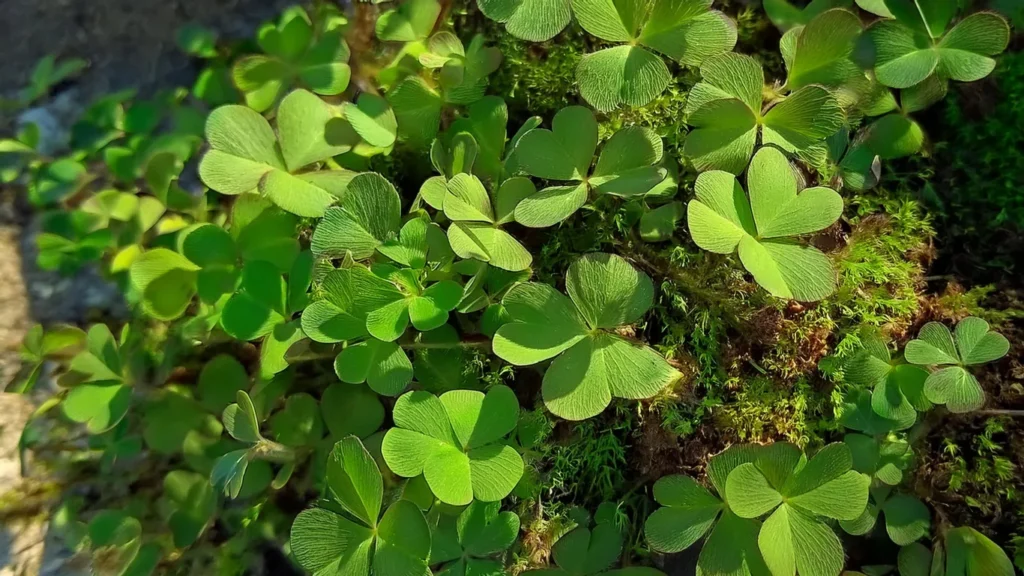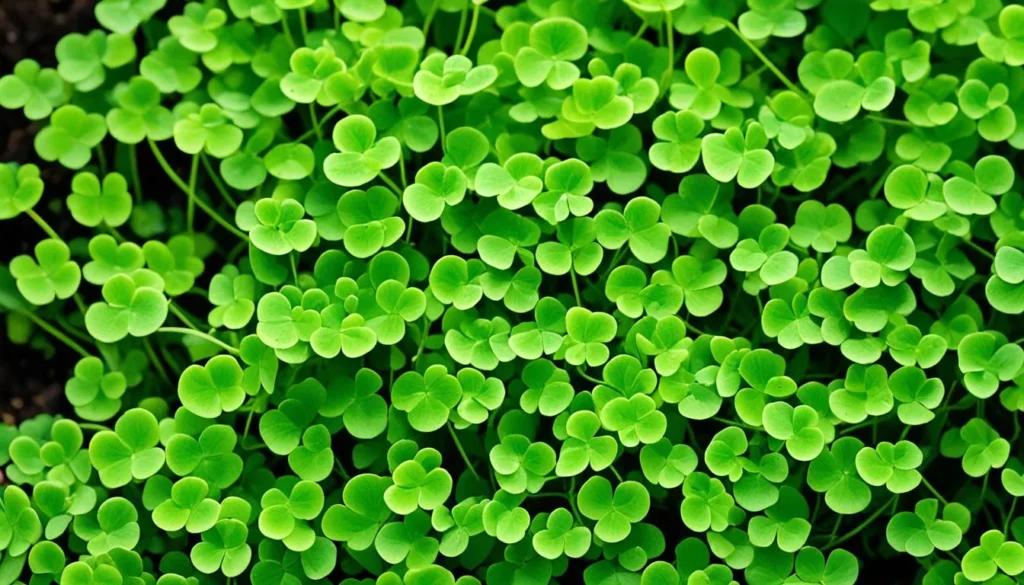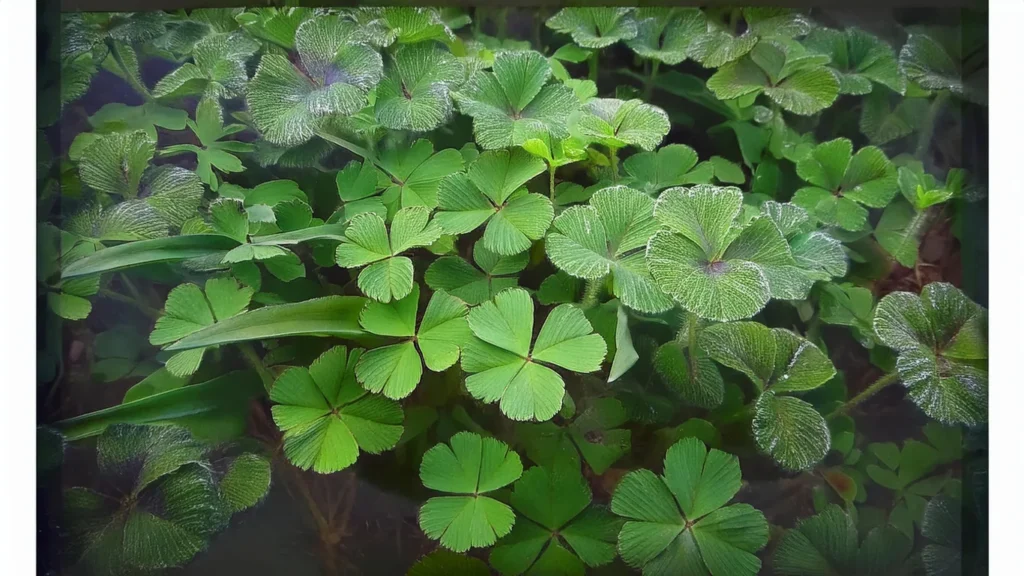Welcome to our comprehensive guide on Marsilea Crenata, the aquatic fern that has captured the imagination of aquarium enthusiasts and aquascapers alike.
In this article, we will take a deep dive into the world of Marsilea Crenata, exploring its unique characteristics, origins, and natural habitat.
We will also provide valuable insights into its cultivation and care, as well as its aesthetic appeal and significance in ecosystems.
So, let’s embark on this journey to unravel the mystique of Marsilea Crenata and discover its role as a captivating carpet plant in freshwater aquariums.

Key Takeaway
- Marsilea Crenata is an aquatic fern and a popular choice as a carpet plant in freshwater aquariums.
- It has a unique leaf structure resembling a four-leaf clover and can thrive fully submerged and partially emerged.
- Marsilea Crenata is native to Southeast Asia and prefers shallow, low-flowing water bodies with sandy or muddy substrates
- Proper cultivation and care involve providing ideal growing conditions, understanding propagation techniques, and maintaining optimal water parameters.
- Marsilea Crenata contributes to the aesthetic appeal of aquascapes and plays a significant role in supporting aquatic biodiversity.
Quick Stats
| Attribute | Details |
| Family Name | Marsileaceae |
| Origin | Southeast Asia |
| Height | 2-5 cm (0.8-2 inches) |
| pH Range | 6.0 – 7.5 |
| CO2 Requirement | Low to Moderate |
| Growth Rate | Slow to Moderate |
| Care Level | Easy to Moderate |
| Color Form | Green, with small, clover-like leaves |
| Water Conditions | 22-28°C (72-82°F), adaptable to a wide range of water hardness |
| Max Size | Leaves spread across the substrate, rarely taller than 5 cm |
| Lighting | Low to Moderate |
| Supplements | Benefits from CO2 supplementation and liquid fertilizers |
| Placement | Foreground |
| Propagation | Rhizome division and runners |
What Is Marsilea Crenata?
Marsilea Crenata, also known as the aquatic fern or carpet plant, is a unique plant species that thrives in freshwater environments.
It belongs to the Marsileaceae family and is native to various regions around the world.
Marsilea Crenata is characterized by its four-leaf clover-like structure and its ability to thrive both fully submerged and partially emerged from the water.
This plant plays a significant role in aquatic ecosystems due to its interactions with other plant species and its contribution to biodiversity.
Understanding the biological characteristics of Marsilea Crenata is essential for its successful cultivation and care.

Origins And Natural Habitat
- Marsilea Crenata, commonly known as the aquatic fern, originates from Southeast Asia, specifically countries like Malaysia, Indonesia, and Thailand. Over time, it has successfully spread to other regions across the globe that provide suitable freshwater habitats for its growth.
- In its natural habitat, Marsilea Crenata thrives in shallow, low-flowing water bodies such as ponds, lakes, and slow-moving streams.
- This unique aquatic plant prefers areas with sandy or muddy substrates, ensuring its roots can anchor and grow effectively.
- Notably, Marsilea Crenata exhibits an impressive adaptability to a wide range of water conditions, including both acidic and alkaline pH levels. This flexibility contributes to its ability to survive and flourish in diverse environments.
Physical Characteristics
- Leaf Shape: Its leaves are clover-shaped, with four leaflets arranged symmetrically around a central point. Each leaflet resembles a small, rounded heart or kidney shape.
- Leaf Texture: The leaves have a smooth and glossy texture, with a slightly waxy surface. This texture helps repel water and prevents excessive moisture loss.
- Coloration: Marsilea crenata typically exhibits various shades of green, ranging from light to dark green, depending on factors such as light intensity and nutrient availability. The coloration may also vary slightly between individual leaflets.
- Size: The size of Marsilea crenata leaves can vary significantly, with mature leaves typically measuring between 1 to 2 inches (2.5 to 5 centimeters) in diameter. However, under optimal conditions, the leaves may grow larger.
Lighting Demands Of The Plant
- Intensity: Marsilea crenata benefits from moderate to high light intensity levels. Providing sufficient lighting ensures proper photosynthesis and healthy growth.
- Duration: Aim for a lighting duration of 8 to 10 hours per day. Consistent lighting schedules help maintain the plant’s biological rhythms and promote robust growth.
- Spectrum: Although Marsilea crenata can adapt to a wide range of light spectra, it tends to perform best under full-spectrum lighting with a color temperature of around 6500 Kelvin. This spectrum closely resembles natural sunlight and supports optimal photosynthesis.
- Penetration: Ensure that the light penetrates through the water column and reaches the substrate where Marsilea crenata is planted. This is particularly important for promoting healthy growth and preventing leggy or weak growth patterns.
- Adjustability: Depending on your setup and the specific needs of your aquatic plants, consider using adjustable lighting fixtures or dimmers to fine-tune the light intensity. This allows you to adapt the lighting to the plant’s requirements as it grows and changes over time.

Temperature Parameter For Optimal Growth
- Temperature Range: Maintain water temperatures between 20°C to 28°C (68°F to 82°F). This range mimics the plant’s natural habitat and supports healthy growth and metabolism.
- Optimal Temperature: Aim for a temperature around 24°C to 26°C (75°F to 79°F) for ideal growth conditions. Within this range, Marsilea crenata exhibits robust growth and vitality.
- Consistency: Ensure temperature stability within the aquarium by using a reliable heater and monitoring fluctuations. Sudden temperature changes can stress aquatic plants, including Marsilea crenata, and may impede growth.
- Seasonal Variations: Consider seasonal temperature fluctuations and adjust heating or cooling mechanisms accordingly to maintain optimal conditions throughout the year.
Water Condition
- Water temperature: Marsilea Crenata thrives in a temperature range of 72-82°F (22-28°C), which provides the ideal conditions for its growth and development.
- pH levels: Aim for a slightly acidic to neutral pH range of 6.5-7.5. This range ensures that the water chemistry suits Marsilea Crenata’s optimal growth.
- Nutrient levels: Marsilea Crenata can obtain nutrients from the substrate and water, but it benefits from regular supplementation. Provide a balanced liquid fertilizer or root tabs to ensure adequate nutrient availability.
- Water circulation and filtration: Good water circulation helps distribute nutrients evenly and prevents stagnant conditions that can lead to algae growth. Adequate filtration helps maintain water clarity and removes any impurities or excess nutrients.
Substrate Requirement
- Fine Gravel or Sand: Marsilea crenata prefers substrates with fine gravel or sand consistency. These substrates allow the plant’s rhizomes to spread and anchor securely while facilitating nutrient uptake.
- Nutrient-Rich: Although Marsilea crenata can adapt to various substrate types, it benefits from nutrient-rich substrates. Consider using an aquatic plant substrate supplemented with root tabs or fertilizer pellets to provide essential nutrients for healthy growth.
- Loose Texture: Ensure the substrate has a loose texture that allows the plant’s rhizomes to spread easily. Compacted substrates may hinder rhizome expansion and lead to poor growth or nutrient deficiency.
- Depth: Maintain a substrate depth of at least 2 to 3 inches (5 to 7.5 centimeters) to accommodate Marsilea crenata’s root system and allow room for rhizome expansion. Deeper substrates provide stability and prevent the plant from uprooting.

Placement Option
- Foreground Planting: It is well-suited for foreground planting due to its low-growing nature and spreading growth habit. Plant it along the front edge of the aquarium or pond to create a lush carpeting effect. Ensure sufficient spacing between individual plants to allow for unhindered growth and prevent overcrowding.
- Midground Accent: Use Marsilea crenata as a midground accent to add texture and interest to the aquascape. Plant it in clusters or groups amid other aquatic plants with varying heights and textures to create depth and visual contrast.
- Rock or Driftwood Attachment: Attach Marsilea crenata rhizomes to rocks or driftwood using fishing line or specialized plant anchors. This placement option adds a naturalistic touch to hardscape elements while allowing the plant to cascade over the substrate for a dynamic effect.
Recommended Tank Size
- For a small to medium-sized aquarium with Marsilea crenata used as a foreground or midground plant, a tank size of at least 10 gallons (approximately 38 liters) can be suitable.
- Larger tanks, such as those ranging from 20 gallons (approximately 76 liters) to 50 gallons (approximately 190 liters) or more, offer greater flexibility in aquascaping and allow for more extensive planting arrangements.
- In ponds or outdoor water features, Marsilea crenata can be planted in shallow areas along pond margins or in dedicated planting containers, regardless of the overall pond size.
Suitable Tank Mates
- Small Fish: Peaceful, non-aggressive fish species like tetras, rasboras, guppies, and small catfish can complement Marsilea crenata’s tranquil environment without disturbing its growth.
- Shrimp: Dwarf shrimp species such as cherry shrimp and amano shrimp are excellent tank mates as they help with algae control and are unlikely to uproot or damage the plants.
- Snails: Some snail species, like nerite snails and Malaysian trumpet snails, can help clean algae and detritus from the substrate without posing a threat to Marsilea crenata.
- Bottom Dwellers: Bottom-dwelling fish such as Corydoras catfish and Otocinclus catfish can peacefully cohabit with Marsilea crenata, occasionally sifting through the substrate without causing damage to the plants.

Nutritional Needs Of The Plant
- Macronutrients: Marsilea crenata primarily requires nitrogen (N), phosphorus (P), and potassium (K), which are essential macronutrients for plant growth. These nutrients can be supplied through water column fertilization or substrate fertilization.
- Micronutrients: In addition to macronutrients, Marsilea crenata also requires essential micronutrients such as iron (Fe), magnesium (Mg), calcium (Ca), and trace elements like manganese (Mn), zinc (Zn), and copper (Cu). These micronutrients are vital for various physiological processes and enzyme functions within the plant.
- Carbon Source: Like most aquatic plants, Marsilea crenata requires a source of carbon for photosynthesis. Carbon dioxide (CO2) is the primary carbon source in aquatic environments. In low-tech setups, CO2 can be naturally provided by fish respiration and decomposition of organic matter. In high-tech setups, supplemental CO2 injection may be necessary to meet the plant’s carbon needs.
Marsilea Crenata Cultivation Tips
- Substrate: Provide a nutrient-rich substrate with good drainage for Marsilea crenata. A mixture of aquarium soil, sand, and gravel works well. Ensure the substrate depth is sufficient for the roots to anchor and spread.
- Lighting: Marsilea crenata thrives under moderate to high lighting conditions. Provide at least 8-10 hours of light per day using full-spectrum aquarium LED or fluorescent lights. Adjust the lighting intensity based on the specific requirements of your setup and the growth rate of the plants.
- CO2 and Nutrients: While Marsilea crenata can grow in low-tech setups, supplementing with CO2 injection and liquid fertilizers can enhance growth and coloration. Ensure proper circulation to distribute nutrients evenly throughout the aquarium.
- Water Parameters: Maintain stable water parameters within the following ranges: pH 6.5-7.5, temperature 20-28°C (68-82°F), and moderate water hardness. Regular water changes are essential to prevent nutrient buildup and maintain water quality.
- Planting Method: Plant Marsilea crenata in small groups or individual stems, spacing them apart to allow for lateral growth. Gently press the rhizomes into the substrate, ensuring they are securely anchored but not buried too deeply.
Plant Propagation Tips
- Runners: Marsilea crenata naturally propagates by sending out horizontal runners, also known as rhizomes. These runners produce new plantlets along their length. To propagate using this method, allow the runners to extend and develop new plantlets. Once the plantlets have developed roots and leaves, carefully detach them from the parent plant and replant them elsewhere in the aquarium.
- Division: Marsilea crenata can also be propagated by dividing the rhizomes. Carefully separate the rhizomes into smaller sections, ensuring that each section has a portion of rhizome and several healthy leaves. Replant these divisions in the substrate, spacing them apart to allow for new growth.
- Sporocarps: Marsilea crenata sporadically produces sporocarps, which are small, round structures that contain spores. These sporocarps develop on the underside of the leaves and can be harvested for propagation. Once the sporocarps mature and release spores, collect them and spread them evenly over the substrate. Keep the substrate moist to encourage spore germination and the development of new plants.
Dealing With Common Pests And Diseases
- One of the challenges in cultivating Marsilea Crenata is dealing with common pests and diseases that can affect its growth and appearance.
- Some of the pests that may pose a threat to this plant include snails, algae, and parasitic insects. Diseases such as fungal infections and bacterial infections can also impact its health.
- To combat these pests and diseases, it is important to regularly inspect the plant for any signs of infestation or infection. Manual removal or introduction of natural predators can be effective control measures if pests are present.
- In the case of diseases, applying appropriate treatments and maintaining a clean and balanced aquatic environment can help prevent the spread of infections.

Ecological Importance And Benefits To The Environment
- Marsilea Crenata plays a crucial role in maintaining the balance and health of aquatic ecosystems. As it thrives in freshwater environments, this plant contributes to preserving aquatic biodiversity.
- Its unique characteristics and interactions with other freshwater plant species create a habitat that offers shelter, serves as a spawning ground, and provides food for various aquatic organisms.
- By cultivating Marsilea Crenata, aquascapers can help support the overall well-being of their aquatic ecosystems and promote sustainable practices.
Conclusion
This plant is a captivating plant that offers a lush and vibrant addition to freshwater aquariums and aquascapes.
Its unique characteristics, such as its four-leaf clover-like structure and ability to thrive both submerged and partially emerged, make it an excellent choice for both beginners and experienced aquascapers.
By understanding the cultivation and care requirements of Marsilea Crenata, aquascaping enthusiasts can create stunning underwater landscapes that showcase the plant’s beauty.
Furthermore, Marsilea Crenata’s ecological significance must be considered.
This plant plays a vital role in aquatic ecosystems, contributing to the balance and health of these environments.
Its interactions with other freshwater plant species provide shelter, food, and spawning grounds for a diverse range of aquatic organisms, enhancing biodiversity and supporting the overall ecosystem.
By incorporating Marsilea Crenata into our aquascapes, we are creating visually appealing displays and contributing to the preservation of aquatic biodiversity.
While cultivating Marsilea Crenata may present some challenges, such as dealing with common pests and diseases and navigating periods of dormancy and temperature fluctuations, these obstacles can be overcome with the right knowledge and practices.
Aquascaping enthusiasts can ensure the plant’s health and vitality by maintaining optimal water parameters, implementing effective propagation techniques, and staying vigilant against potential threats.
With proper care, Marsilea Crenata will thrive, creating lush carpets and adding a touch of natural beauty to your aquatic landscapes.
Frequently Asked Questions
How Can I Propagate Marsilea Crenata For Healthy Growth And Coverage?
This plant can be propagated using best practices such as ensuring proper water parameters and providing suitable growing conditions.
What Are The Ideal Water Parameters For Marsilea Crenata Care?
The ideal water parameters for Marsilea Crenata care include maintaining optimal temperature, pH, and nutrient levels.
What Is The Significance Of Marsilea Crenata In Ecosystems?
This plant plays a significant role in aquatic ecosystems by contributing to aquatic biodiversity and providing shelter, food, and spawning grounds for aquatic organisms.
What Challenges May Arise In Cultivating Marsilea Crenata?
Challenges in cultivating this plant can include dealing with common pests and diseases, navigating periods of dormancy, and adjusting to temperature fluctuations.
What Are The Benefits And Uses Of Marsilea Crenata?
Marsilea Crenata offers benefits such as contributing to the environment, potential use in aquatic horticulture, and enhancing the aesthetics of freshwater aquariums.
- Unveiling The Wonders Of Riccia Fluitans In Aquascapes - August 7, 2024
- Vallisneria Gigantea Var. Guide To Care And Cultivation At Home - July 31, 2024
- Vesicularia Dubyana Care & Growth Guide Tips For Beginner Gardeners - July 30, 2024
